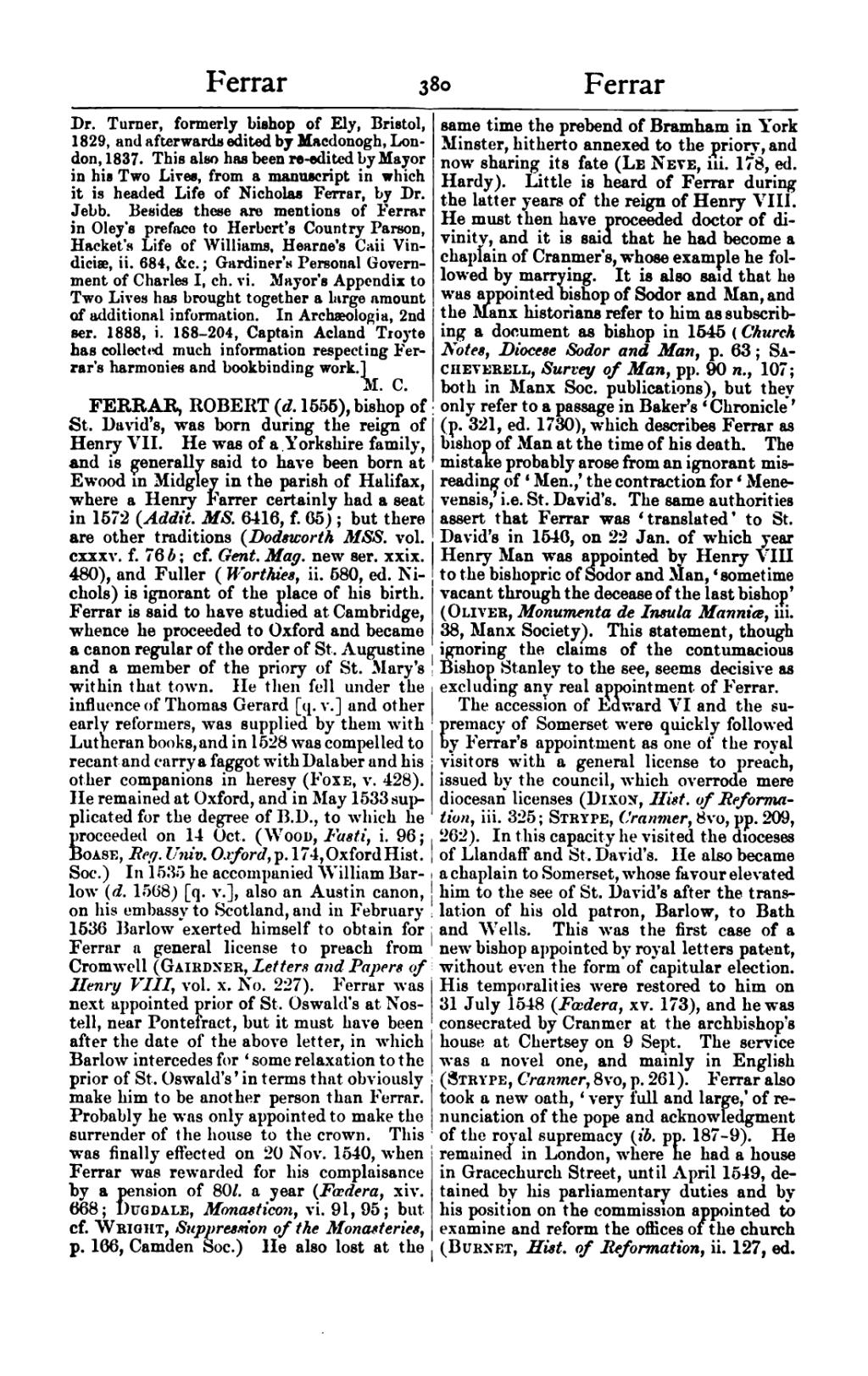Dr. Turner, formerly bishop of Ely, Bristol, 1829, and afterwards edited by Macdonogh, London, 1837. This also has been re-edited by Mayor in his Two Lives, from a manuscript in which it is headed Life of Nicholas Ferrar, by Dr. Jebb. See also The Story-books of Little Gidding, ed. E. C. Sharland, 1899; Carter's Nicholas Ferrar, his household and friends, 1892; Emma Marshall's Haunt of Ancient Peace, 1897. Mentions of Ferrar are in Oley's preface to Herbert's Country Parson, Hacket's Life of Williams, Hearne's Caii Vindiciæ. ii. 684, &c.; Gardiner's History. In Archæologia, 2nd ser. 1888, i. 188–204, Captain Acland Troyte has collected much information respecting Ferrar's harmonies and bookbinding work.]<smaller block/e>
FERRAR, ROBERT (d. 1555), bishop of St. David's, was born during the reign of Henry VII. He was of a Yorkshire family, and is generally said to have been born at Ewood in Midgley in the parish of Halifax, where a Henry Farrer certainly had a seat in 1572 (Addit. MS. 6416, f. 65); but there are other traditions (Dodsworth MSS. vol. cxxxv. f. 76 b; cf. Gent. Mag. new ser. xxix. 480), and Fuller (Worthies, ii. 580, ed. Nichols) is ignorant of the place of his birth. Ferrar is said to have studied at Cambridge, whence he proceeded to Oxford and became a canon regular of the order of St. Augustine and a member of the priory of St. Mary's within that town. He then fell under the influence of Thomas Gerard [q. v.] and other early reformers, was supplied by them with Lutheran books, and in 1528 was compelled to recant and carry a faggot with Dalaber and his other companions in heresy (Foxe, v. 428). He remained at Oxford, and in May 1533 supplicated for the degree of B.D., to which he proceeded on 14 Oct. (Wood, Fasti, i. 96; Boase, Reg. Univ. Oxford, p. 174, Oxford Hist. Soc.). In 1535 he accompanied William Barlow (d. 1568) [q. v.], also an Austin canon, on his embassy to Scotland, and in February 1536 Barlow exerted himself to obtain for Ferrar a general license to preach from Cromwell (Gairdner, Letters and Papers of Henry VIII, vol. x. No. 227). Ferrar was next appointed prior of St. Oswald's at Nostell, near Pontefract, but it must have been after the date of the above letter, in which Barlow intercedes for ‘some relaxation to the prior of St. Oswald's’ in terms that obviously make him to be another person than Ferrar. Probably he was only appointed to make the surrender of the house to the crown. This was finally effected on 20 Nov. 1540, when Ferrar was rewarded for his complaisance by a pension of 80l. a year (Fœdera, xiv. 668; Dugdale, Monasticon, vi. 91, 95; but cf. Wright, Suppression of the Monasteries, p. 166, Camden Soc.). He also lost at the same time the prebend of Bramham in York Minster, hitherto annexed to the priory, and now sharing its fate (Le Neve, iii. 178, ed. Hardy). Little is heard of Ferrar during the latter years of the reign of Henry VIII. He must then have proceeded doctor of divinity, and it is said that he had become a chaplain of Cranmer's, whose example he followed by marrying. It is also said that he was appointed bishop of Sodor and Man, and the Manx historians refer to him as subscribing a document as bishop in 1545 (Church Notes, Diocese Sodor and Man, p. 63; Sacheverell, Survey of Man, pp. 90 n., 107; both in Manx Soc. publications), but they only refer to a passage in Baker's ‘Chronicle’ (p. 321, ed. 1730), which describes Ferrar as bishop of Man at the time of his death. The mistake probably arose from an ignorant misreading of ‘Men.,’ the contraction for ‘Menevensis,’ i.e. St. David's. The same authorities assert that Ferrar was ‘translated’ to St. David's in 1546, on 22 Jan. of which year Henry Man was appointed by Henry VIII to the bishopric of Sodor and Man, ‘sometime vacant through the decease of the last bishop’ (Oliver, Monumenta de Insula Manniæ, iii. 38, Manx Society). This statement, though ignoring the claims of the contumacious Bishop Stanley to the see, seems decisive as excluding any real appointment of Ferrar.
The accession of Edward VI and the supremacy of Somerset were quickly followed by Ferrar's appointment as one of the royal visitors with a general license to preach, issued by the council, which overrode mere diocesan licenses (Dixon, Hist. of Reformation, iii. 325; Strype, Cranmer, 8vo, pp. 209, 262). In this capacity he visited the dioceses of Llandaff and St. David's. He also became a chaplain to Somerset, whose favour elevated him to the see of St. David's after the translation of his old patron, Barlow, to Bath and Wells. This was the first case of a new bishop appointed by royal letters patent, without even the form of capitular election. His temporalities were restored to him on 31 July 1548 (Fœdera, xv. 173), and he was consecrated by Cranmer at the archbishop's house at Chertsey on 9 Sept. The service was a novel one, and mainly in English (Strype, Cranmer, 8vo, p. 261). Ferrar also took a new oath, ‘very full and large,’ of renunciation of the pope and acknowledgment of the royal supremacy (ib. pp. 187–9). He remained in London, where he had a house in Gracechurch Street, until April 1549, detained by his parliamentary duties and by his position on the commission appointed to examine and reform the offices of the church (Burnet, Hist. of Reformation, ii. 127, ed.
